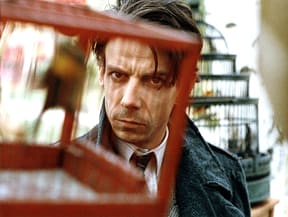The premise of Max is quite interesting and has, sight unseen, attracted a lot of controversy already. The film, set in 1918 Munich, imagines an uneasy friendship between a young Jewish art dealer, Max Rothman (John Cusack) and a young aspiring artist, Adolf Hitler (Noah Taylor). Max, a former painter who lost his arm in the war, begins to encourage the poverty-stricken Hitler, driven by a combination of pity and understanding (both men having just emerged from World War One scarred from their experiences). Hitler is portrayed as squirrelly, insecure, unstable and volatile, desperately wanting to succeed and be admired as an artist, but unable to properly channel his emotions into his art work. At the same time, he is being schooled by the German army in the art of propaganda, and getting paid to make anti-Semitic speeches in beer halls. Politics and polemics obviously prove an easier path for Hitler, and thus the monstrously familiar figure emerges.
The critics of Max worry that any attempt to "humanise" Hitler detracts from his horrific deeds, but it's far more dangerous to pretend that figures such as Hitler emerge from a vacuum to assume their place in history. Max, aided by Noah Taylor's remarkable performance, does well in creating a frighteningly human Hitler, examining the personal and societal factors that shape him while showing no sympathy for his actions and decisions.
The film is full of compelling ideas; it has plenty of interesting things to say about art and politics, war and history. The problem is that it almost always feels like ideas being explicated, rather than a story being offered up to be experienced. Part of that has to do with being automatically distanced by the ingrained Hitler associations, but it also suffers from a title character that rarely comes alive to do much more than serve as a mouthpiece for the script's ideas about art's liberating potential.
Writer/Director Menno Meyjes (best known as a screenwriter for Spielberg on The Colour Purple, Empire of the Sun, and Indiana Jones and the Last Crusade) purposely gives the film a contemporary feel, setting Max's gallery in a massive train warehouse and depicting living quarters as airy lofts and houses with glass brick walls. While an interesting attempt to make it easier to relate to the action, this nod to current aesthetics also detracts from creating an authentic and believable 1918 Germany, which distances us all the more.
The critics of Max worry that any attempt to "humanise" Hitler detracts from his horrific deeds, but it's far more dangerous to pretend that figures such as Hitler emerge from a vacuum to assume their place in history. Max, aided by Noah Taylor's remarkable performance, does well in creating a frighteningly human Hitler, examining the personal and societal factors that shape him while showing no sympathy for his actions and decisions.
The film is full of compelling ideas; it has plenty of interesting things to say about art and politics, war and history. The problem is that it almost always feels like ideas being explicated, rather than a story being offered up to be experienced. Part of that has to do with being automatically distanced by the ingrained Hitler associations, but it also suffers from a title character that rarely comes alive to do much more than serve as a mouthpiece for the script's ideas about art's liberating potential.
Writer/Director Menno Meyjes (best known as a screenwriter for Spielberg on The Colour Purple, Empire of the Sun, and Indiana Jones and the Last Crusade) purposely gives the film a contemporary feel, setting Max's gallery in a massive train warehouse and depicting living quarters as airy lofts and houses with glass brick walls. While an interesting attempt to make it easier to relate to the action, this nod to current aesthetics also detracts from creating an authentic and believable 1918 Germany, which distances us all the more.
